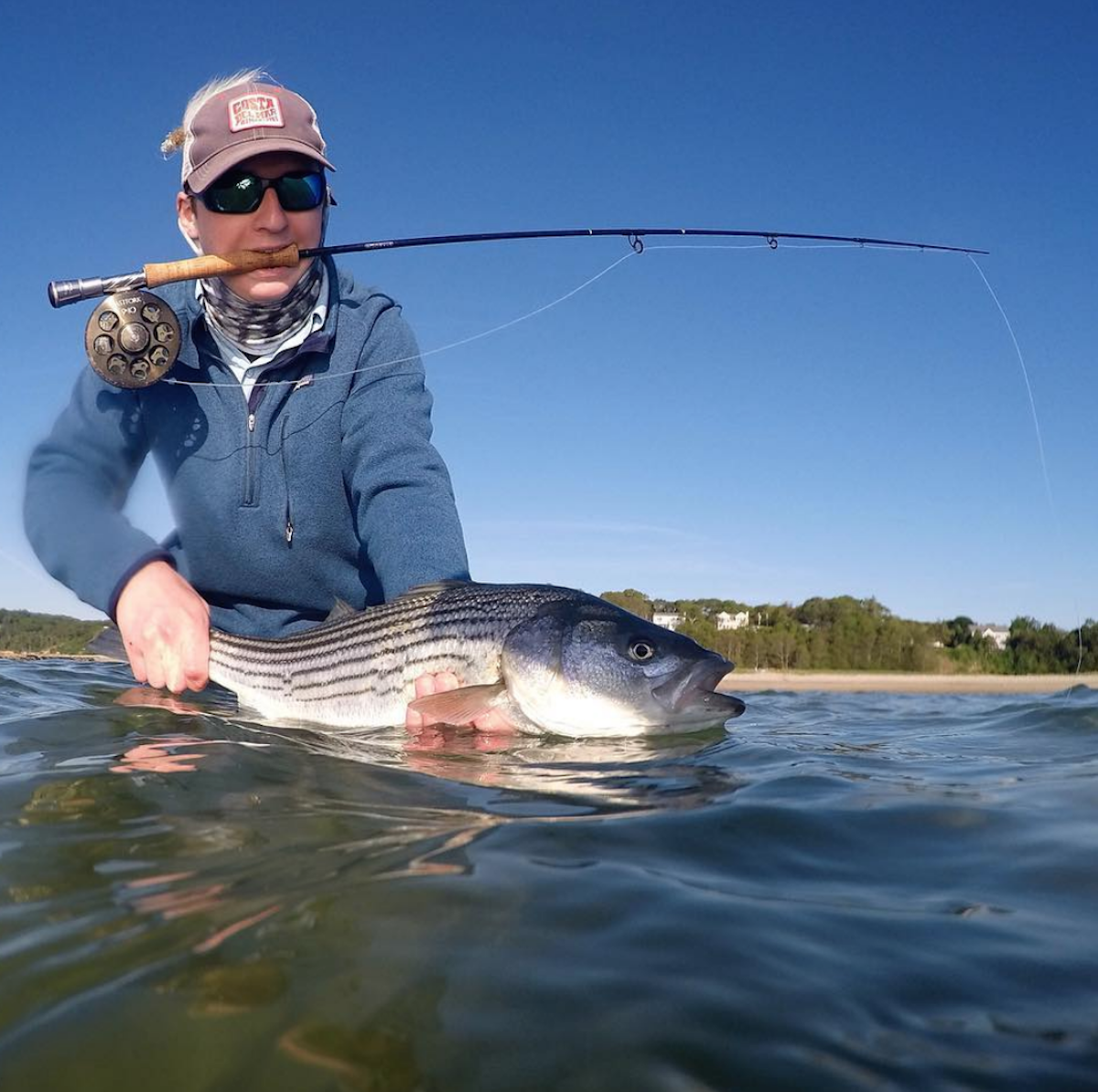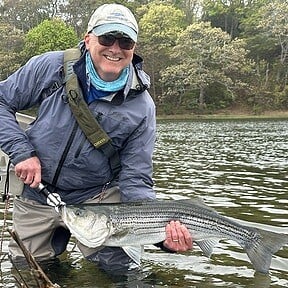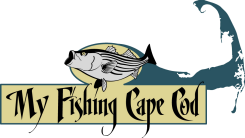When it comes to hunting for trophy striped bass along the pristine shores of Cape Cod and New England, a variety of striped bass flies will work. From sand eels to bunker, lady crabs to river herring, carefully crafted striper flies have been perfected over the generations to mimic the preferred prey of striped bass.
Whether you're casting from the surf-pounded beaches of the Outer Cape or drifting through the calm backwaters of Pleasant Bay, having the right flies for striper fishing can mean the difference between a memorable day of fly fishing and a fruitless day on the water.
Choosing the best flies for striped bass requires considering factors such as water depth, time of day, and seasonal patterns. From the classic Clouser Minnow to the locally-developed sand eel flies, each striper fly in your arsenal should serve a specific purpose in your pursuit!

This 14 inch Beast Fleye by MFCC member Johan Frenje is certain to get the attention of any trophy striped bass in the area! You can read more about this creation (and many more) by scroling below.
The most effective saltwater flies for stripers often imitate local baitfish such as sand eels, herring, and menhaden. Experienced fly tiers on the Cape have developed saltwater flies for striped bass that not only look like these forage species but also behave like them in the water, triggering the predatory instincts of hungry stripers.
In this post, we'll explore My Fishing Cape Cod members' favorite striped bass flies, while sharing insights from our membership community, as well as some time-tested techniques that will hopefully help you land more fish on your next outing!
Special thank you to My Fishing Cape Cod members Kevin Adley for sending me an article about his favorite striper flies. Special thanks as well to members Johan Frenje and Ken Holt for sharing your favorite striped bass flies to the Fly Tying thread inside our forum.
This post would not have been possible without your contributions!

Five of the flies you are about to read about were shared by MFCC member Kevin Adley. Thank you Kevin!

Seven of the flies you are about to read about were shared by MFCC member Johan Frenje. Thank you Johan!

Four of the flies you are about to read about were shared by MFCC member Kevin Adley. Thank you Kevin!
Enhanced Crab-Pot Pattern
This innovative redesign by MFCC member Johan Frenje features frostip rabbit strips replacing traditional saddle hackle for the claws. This helps to create a more three-dimensional presentation that better mimics a green crab's natural movement.
According to Johan, "If it will fish better remains to be seen but I do have more confidence in this design, which matters."

Photo by Johan Frenje.
A Variation Of The Redfish Ritalin
According to MFCC member Kevin Adley, his all-time favorite fly for flats fishing for striped bass is a New England variation of the Redfish Ritalin, originally tied by 239 Flies.

Photo by Owen Colbert.
A long time fishing partner of Kevin's, Owen Colbert (who is an outstanding fly tier and flats fisherman himself) recently experimented by tying this fly with bigger hooks and different materials.
Kevin and Owen have also experimented by tying the Redfish Ritalin with blue and tan colors (shown below). According to Kevin, this fly is an outstanding shrimp pattern, and striped bass cruising the shallow flats often show an interest in it. Add some heavy dumbbell eyes and any bass that is keyed in on crabs along the bottom find may find it completely irresistible.

Photo by Owen Colbert.
9 inch Hollow Deceiver
This impressive pattern from Johan Frenje combines hollow-tied bucktail with craft fur, peacock herl, and saddle hackle to create a substantial profile.
Conceived as a deceiver variant of the popular Conomo Special, this fly is specifically designed for early-season striped bass fishing. The hollow-tying technique helps maintain a large profile while keeping the fly relatively light and castable.

Photo by Johan Frenje.
The Olive & White Hollow Fleye
According to MFCC member Kevin Adley, one fly that has produced a lot of stripers for him in the Plymouth area when fishing near menhaden schools is the olive and white hollow fleye, created by legendary fly tier Bob Popovics.
Kevin claims that the action on this fly is incredible, and the profile of the fly mirrors bunker very well. While there are many ways to fish this fly, Kevin fishes it by doing long and slow strips, with pauses in between. This technique gets the best action out of the fly. When the fish are aggressive, Kevin tends to increase the speed and frequency of his strips.

Photo by Owen Colbert.
Kevin prefers to use sparse clumps in this fly because it allows the hollow fly to be a hollow fly and not a Bucktail deceiver. By reverse tying with sparse clumps of bucktail, you are able to allow the fibers to naturally breathe in the water when you strip the fly in. This creates the illusion of having a lot of bucktail when you really don't.
Kevin does mention that when first tying in the sparse clump of bucktail, it is common to think that this possibly can't be enough. However, when you tie five or six clumps it all adds up to create the desired result. One bucktail can make a dozen or more of these flies. According to Kevin, you can toss 8-9 inch hollows on an eight weight fly rod all day.
The Semper Fleye
The Semper Fleye, another innovative pattern from Bob Popovics, represents the evolution of his groundbreaking designs. This fly combines the profile-building techniques of the Hollow Fleye with improved durability and casting characteristics.
Built on a shorter shank hook with a carefully planned blend of synthetic fibers, the Semper Fleye creates a broad, lifelike profile in the water while maintaining a compact shape during casting. It's particularly effective when stripers are feeding on larger baitfish like herring, mackerel, or menhaden. The fly's design allows it to push water and create enticing vibrations during the retrieve, triggering aggressive strikes from hunting stripers.
Anglers can tie this pattern in various color combinations to match local forage, with the blue-over-white and olive-over-white being particularly effective combinations for matching common baitfish. Recently Ken Holt has been paying tribute to Bob by practicing his personal version of the Semper Fleye - The Semper Squid.

Photo by Ken Holt.
Articulated Squid Series
Johan Frenje drew inspiration from Rupert Harvey's Semper squid, to create these flies which feature a sophisticated construction using a 28mm Big-game shank paired with a 1/0 Ahrex SA270 bluewater hook.

Photo by Johan Frenje.
The materials list includes:
- Grey/brown barred marabou
- Light-pink marabou over Chocklett's finesse body chenille
- Tri-color saddle hackle (white, pink, and brown chinchilla)
- Rupert's invisible tab eyes
These flies are specifically designed for fishing the Monomoy rips in late June.
Kinky Muddlers
Recently Johan Frenje took a week away from the vice, but now he's back and feeling good. Currently he's working on 8-9 inch Kinky Muddlers to imitate American eels (a favorite prey item of big striped bass).
For the Kinky Muddler shown below Johan used Ahrex SA210 2/0 and 3/0 hooks. He didn’t have white Steve Farrar fibers so he had to order some and in the meantime keep the ties on hold. Be sure to check the Fly Tying thread in our forum to see the finished product.

Photo by Johan Frenje.
The Flatwing
The next on Kevin Adley's list of best striper flies is the Flatwing-a simple yet very effective pattern for striped bass. It consists of bucktail with one or more hackles (feathers) tied at the tail section of the fly.

Photo by Owen Colbert.
A flatwing is a very good pattern when bass are keyed in on smaller, thinner baitfish. In addition, when you have multi-feather flat wings you can imitate tinker mackerel very well. Kevin prefers either all plain white-colored, or patterns which have a few strands of olive thrown over white bucktail.
Modified Conomo Special
Johan Frenje's adaptation of Rich Murphy's classic pattern incorporates:
- ¾" diameter E-Z body
- Squimpish hair
- Craft fur and bucktail
- Ahrex 3/0 Clouser hook
- Solarez Flex coating for durability
The pattern maintains an effective broad profile whether fished in calm or moving water, making it particularly effective in shallow inlets.

Photo by Johan Frenje.
The Surf Candy
Another Popovics creation, the Surf Candy is an excellent choice for imitating sand eels and other slender baitfish. It's particularly effective when fishing for stripers in the surf. The Surf Candy's epoxy or UV resin coating not only creates a translucent, realistic profile that mimics the subtle sheen of small baitfish, but also makes the fly incredibly durable.
This durability is crucial when targeting aggressive stripers that can shred traditional flies after just a few hits. Anglers can tie this pattern in various colors to match local baitfish, but the classic olive-over-white combination has proven deadly when stripers are keyed in on sand eels. Fish this fly with short, quick strips to imitate a fleeing baitfish, or let it sink and retrieve it slowly near the bottom where stripers often ambush their prey.
Here's MFCC member Ken Holt's take on the legendary Surf Candy!

Photo by Ken Holt.
The Clouser Minnow
The Clouser Minnow is perhaps the most versatile of all striper flies. Its simple design imitates a wide variety of baitfish, making it one of the best flies for striped bass in various conditions.
Kevin Adley's go-to fly for early season and late season striped bass is the clouser minnow. Kevin agrees that the clouser minnow is arguably the most popular and effective fly for anything that swims!

Photo by Owen Colbert.
The primary way Kevin ties his clouser is with all the bucktail tied on the bottom of the hook. This is commonly called the “Flats Clouser”.
The Clouser is great at imitating silver sides, sand eels, or anything relatively small. According to Kevin, the way to fish this fly is by using quick, short strips when the fish are aggressive. When the fish are sluggish (in either really warm water or really cold water) the trick is to slow down your speed - even if you already believe you are going as slow as possible.
For Kevin, the color that schoolie-size stripers go crazy over is chartreuse and white. This pattern is great to throw when you are fishing new waters as almost any striper that sees it will take it.
In Kevin's experience there have been countless times where the stripers have completely destroyed his clouser, with hardly any bucktail remaining, and the dumbbell eyes hanging on by a thread. Kevin adds that you do have to be careful throwing this fly as even being hit with a small #1 clouser feels like getting hit with an orange!
Christmas Conomo Special
This innovative seasonal variation from MFCC member Ken Holt is tied on a Gamakatsu 4/0 hook. This pattern features thrift store Christmas ribbon and a flexible mesh cone head.

Photo by Ken Holt.

Photo by Ken Holt.
Ken reports that he's a little concerned about the small space between the body and the hook point, and how it could impact hook up ratio. With that said, the cone head is flexible mesh so Ken hopes that it will simply flex out of the way when the fly is hit.
The Lefty's Deceiver
From the perspective of Kevin Adley, no striped bass flies list would be complete without the Lefty's Deceiver. Tied by the legend himself, Lefty Kreh, this fly has caught stripers of all sizes.

Photo by Owen Colbert.
Kevin states that the Lefty's Deceiver can be tied in a variety of different colors. The most common colors are olive and white, or chartreuse and white.
This pattern is great for imitating larger peanut bunker that are around later in the season. However many different baitfish can be effectively imitated with a Lefty's Deceiver.
6 inch Articulated Lobster
The crustacean theme has been becoming more and more popular inside our Fly Tying 2025 forum thread! Here is a 6” articulated lobster fly by Johan Frenje. Last season Johan found an area with lots of juvenile lobsters so he's looking forward trying this one in that area during the upcoming season.

Photo by Johan Frenje.
Dubbed Body Squimp
Here's another simple yet effective pattern from MFCC member Ken Holt that demonstrates how basic materials and techniques can create highly effective flies.
Ken is planning on using this pattern over the shallow water flats in 2025.

Photo by Ken Holt.
Beast Fleyes
Throughout the winter of 2025 Johan has been working on his 14 inch Beast Fleyes. These fleyes take hours to tie, turning his tying desk into a total mess!
Nevertheless the finished product is well worth the effort. Here's Johan's 14 inch Beast on a 5/0 Ahrex SA210 hook.

Photo by Johan Frenje.
Tips for Fishing with Striped Bass Flies
To make the most of these flies for striper fishing, keep these tips in mind:
Conclusion: Mastering the Art of Striper Flies
By mastering the use of these saltwater flies for stripers and understanding the behavior of your target species, you'll increase your chances of landing that trophy striped bass. Whether you're fishing in the surf, from a boat, or in estuaries, having a well-stocked fly box with some of these striped bass flies will set you up for success.
In conclusion, these patterns represent more than just materials on hooks - they showcase the creativity, knowledge, and dedication of MFCC's fly tying community. Whether these flies are pleasing to the tier's eye or the fish's, they represent countless hours of experimentation and refinement, all aimed at creating more effective tools for our shared passion of fishing.
Thank you again Kevin, Johan and Ken for posting your work to our forum. I really appreciate it.
Tight lines!




Is there anywhere on the cape – or internet to order the redfish Ritalin and what hook size? thanks!
I honestly don’t know Bradley, but in Barnstable Harbor (which for anyone else reading this is where Bradley plans on fishing) I have done well with many different flies. During May and June I like to use real big flies like 7-9 inches that imitate herring and mackerel. When the sand eels are in during the summer it would probably pay to have a fly that is smaller and more slender. Something in the 3-4 inch range would be good for imitating general baitfish such as mummichogs, and of course later in the summer/fall, peanut bunker.
Great choices Kevin! I also love the Jiggy, a weighted fly by Bob Popovics which is similar to the Clouser but with a nose cone instead of barbells. Great for the Monomoy and Brewster flats. Very easy to tie yourself as well. Many years ago I was at a tackle shop in Seaside Park, NJ with my foster son. He was very into fly fishing while I knew almost nothing. As we entered the shop he whispered with a sense of awe, “that guy over there is Bob Popovics”. My brilliant uninformed reply, “who the hell is Bob Popovics”?
Great story! LOL
Hi there, great article. Can you explain a bit about the difference between using weighted vs. unweighted flies? Bit confused when to use a weighted fly if using an intermediate or sinking line. Just gives it different action?
Thanks,
Derek
I’m new to saltwater fly fishing how do I get started with fly toying and flyfish for striper in Rhode Island and Mass
Hey Patrick ?One good resource is our fly fishing forum. We have quite a few members who like to tie their own flies. LMK if you decide to sign up and join our forum. It’d be great to have you onboard!
Hey Patrick,
This presentation on MFCC will be very helpful to you. Search “fly fishing 101” or use this link. https://myfishingcapecod.com/fly-fishing-101/
Hey Kevin,
What size hook do you typically recommend for the hollow flies?
Nice article Kevin, do you mind sharing tying materials, hook size and how you fish the redfish Ritalin?
Thanks,
Peter
Hi Ryan
I believe that the picture of the Lefty Kreh Deceiver and the Flatwing picture are interchanged in the Kevin Adley 5 Favorite Flies article. Article and pictures are very nice.
Rit
Great article,,,lots of knowledge for sure, would love to see these flys in action with a nice bass hanging off the hook…
Great blog! I am not a fly fisherman, yet…..but I use flys all the time as teasers off a drop loop on my leader. This past weekend on the beach in truro the teaser took 80% of the fish.
I will have to get the ones you mentioned, thanks.